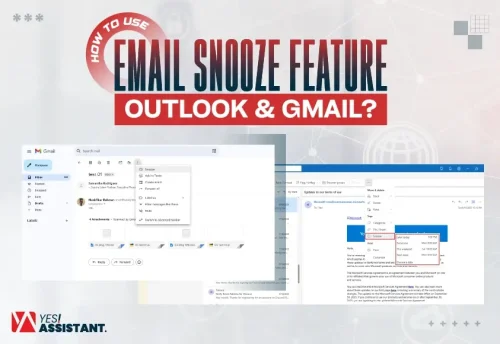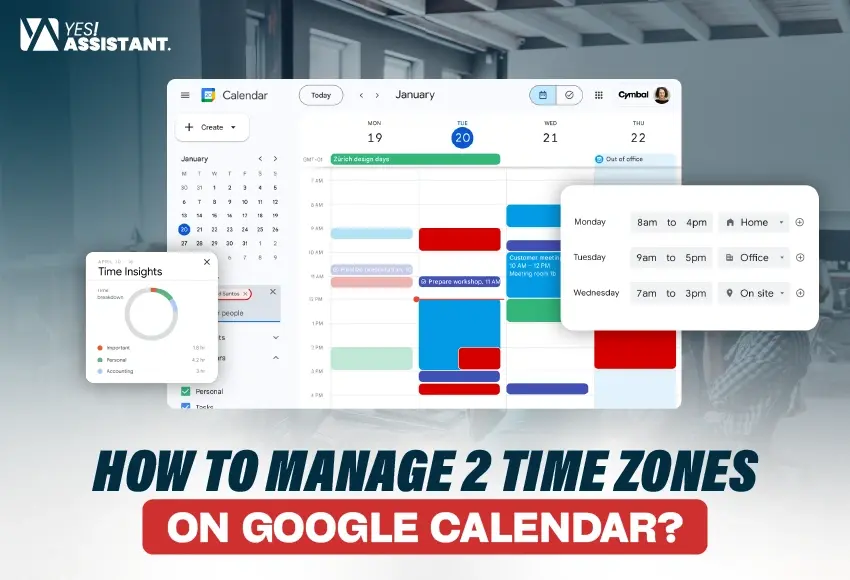
How to Manage 2 Time Zones on Google Calendar [With Examples]
Managing two time zones on your Google Calendar might be intimidating, yet it is essential. Whether you work with a remote team or handle international clients, having two time zones in your calendar is a blessing in disguise.
People working across multiple time zones and regions often miscalculate the time differences. In the worst-case scenario, this can cause significant harm to individuals and companies. However, the solution is very simple and effective.
In this detailed tutorial, you will learn how to manage 2 time zones on Google Calendar. The tutorial covers step-by-step instructions, expert tips, and practical use cases.
From enabling a secondary time zone to syncing across multiple devices, this guide will help you fast-track your schedule and avoid time mishaps.
What's Inside
- Why Time Zone Management Is a Must
- Step-by-Step: Add a Secondary Time Zone in Google Calendar
- Create Events in Two Different Time Zones
- Use the World Clock for Better Visibility
- Mobile Device Sync & Time Zone Behavior
- Time Zone Tools Beyond Google Calendar
- Common Mistakes to Avoid When Managing Time Zones
- Not Updating Your Time Zone While Traveling
- Overlooking Daylight Savings Time (DST) Changes
- Manually Changing Event Times Without Adjusting Time Zones
- Ignoring Time Zone Settings on Shared Events
- Creating Recurring Events Without Checking Time Zones
- Quick Summary – Common Time Zone Mistakes
- Expert Tip: Test New Scheduling with a Dummy Event
- Final Tips for Managing Time Zones Like a Pro
- Set Up Default Time Zones for Convenience
- Use Time Zone Reminders for Critical Meetings
- Schedule Flexibly Across Different Time Zones
- Be Cautious with One-Time Events Across Time Zones
- Always Keep Time Zones in Mind During the Planning Stage
- Quick Summary – Final Tips for Time Zone Mastery
- Expert Tip: Use a Shared Time Zone Chart for Global Teams
- Conclusion
Why Time Zone Management Is a Must
Managing multiple time zones is no joke. It can be a lifesaver, especially for remote work and international collaboration. It is necessary to keep proper track of your schedules in Google Calendar.
However, if you coordinate between global clients and teammates, multiple time zones will save a lot of hassle and prevent further collusion.
The Rise of Remote Work and Global Teams
You must consider several factors, such as coordination, overlaps, delays, and missed meetings. These factors can jeopardise your hard work during remote opportunities. Calendar management skills are efficient for virtual assistants.
Especially after the horrible COVID-19 pandemic, nearly 50% of the global workforce prefers remote work. Leading professionals in the market spend a great deal of time crafting their schedules and timelines across different regions.
Google Calendar simplifies this by offering time zone settings that make planning seamless, even if you’re juggling multiple regions daily.
Common Scheduling Mistakes Without Time Zone Setup
Not setting time zones manually or forgetting to adjust them when traveling causes significant communication gaps. Misalignment between your calendar and others’ can result in:
- Missed deadlines.
- Late or early meeting attendance.
- Poor client impressions.
- Double booking.
Using built-in time zone tools reduces these risks significantly.
Benefits of Using Google Calendar for Time Zones
Google Calendar automatically adjusts events based on each user’s local time zone. When used correctly, it:
- Updates events as you change locations.
- Reflects accurate times for all attendees.
- Removes the need for manual conversion.
- Displays multiple zones at once (with World Clock).
These features make it one of the most reliable tools for time zone-based scheduling.
Who Should Use This Feature?
This functionality benefits:
- Freelancers working internationally.
- Teams with members in different countries.
- Travelers managing schedules across borders.
- Managers running remote meetings across time zones.
Understanding and using time zones in Google Calendar is a significant productivity booster, even if you’re in one place.
Expert Tip: Label Your Time Zones for ClarityWhen adding a second-time zone, label it clearly, such as “Client: EST” or “Team: PST.” It prevents confusion, especially if you’re switching between projects or roles. You can add these labels under Settings > Time Zone > Label, and they’ll appear next to your calendar’s time grid. |
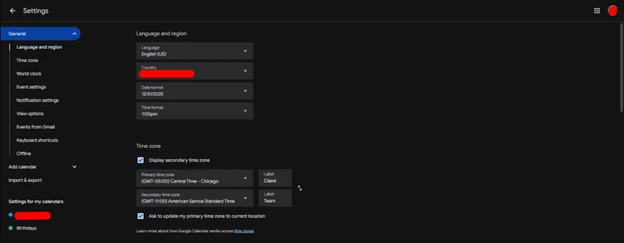
Labeling time zones according to their criteria
Step-by-Step: Add a Secondary Time Zone in Google Calendar
Adding a secondary time zone in Google Calendar helps you track multiple regions at a glance. This feature is perfect for coordinating with clients, teams, or family members worldwide.
Google Calendar allows you to display a second time zone next to your primary one on the calendar view. Here’s how to set it up.
How to Add a Second Time Zone on Desktop
This feature is only available on the web version of Google Calendar. Follow these steps:
- Open Google Calendar in your browser.
- Click the gear icon at the top-right corner and select Settings.
- Scroll down to the Time Zone section on the left menu.
- Check the box labeled “Display secondary time zone.”
- Choose your second time zone from the drop-down list.
- (Optional) Add a custom label for each time zone, such as:
-
- Primary Time Zone: “Local – PST”
- Secondary Time Zone: “Client – EST”
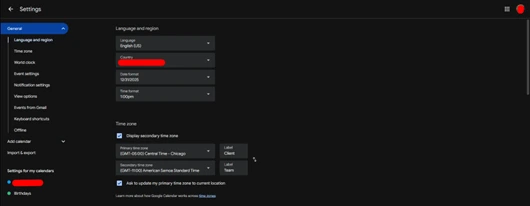
7. Your changes will be saved automatically.
After enabling this, your calendar will display two-time zone markers, making it easy to see both local and remote times simultaneously.
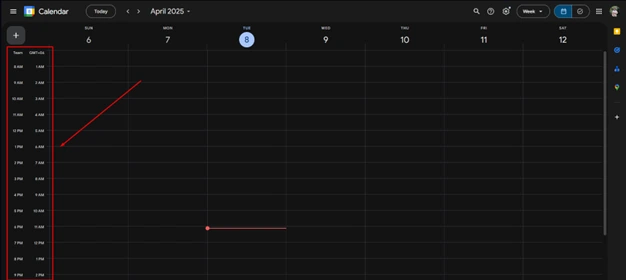
Added different time zones for correspondents
How the Two Time Zones Are Displayed
Once enabled, the two time zones will appear on the left-hand side of your calendar grid. This visual guide helps:
- Reduce scheduling errors.
- Compare time slots at a glance.
- Simplify event planning across zones.
This works particularly well in the Week and Day calendar views.
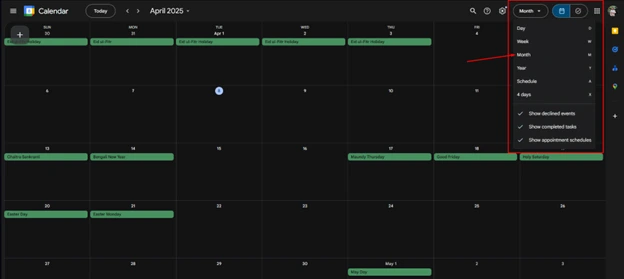
Daily/Weekly/Monthly Grid View Preferences
What You Can’t Do on Mobile (Limitations)
Unfortunately, Google Calendar’s mobile app (Android and iOS) doesn’t support the dual time zone display.
Here’s what you can do on mobile:
- Your events auto-adjust based on the device’s time zone.
- The time zone can be updated via Settings > General > Use device time zone.
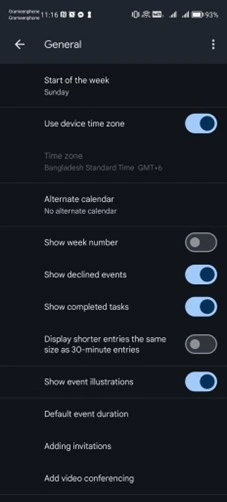
You must use the desktop version if you need to add or view a secondary time zone
Quick Summary – Add a Secondary Time Zone● Go to Settings → Time Zone. ● Check the Display secondary time zone. ● Add custom labels for easy recognition. ● Use desktop browser; mobile support is limited. |
Expert Tip: Use Chrome Desktop Mode on MobileIf you’re on mobile and need to set a second time zone, open Chrome, go to Google Calendar, tap the three dots in the top right corner, and select “Desktop site.” |
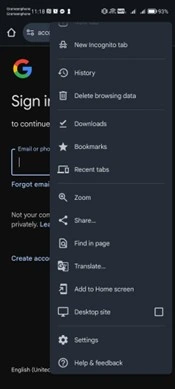
Expert Tip: Use Chrome Desktop Mode on MobileIf you’re on mobile and need to set a second time zone, open Chrome, go to Google Calendar, tap the three dots in the top right corner, and select “Desktop site.” It allows you to access the full desktop settings, including the option to add a secondary time zone, even from your phone. |
Create Events in Two Different Time Zones
Creating events is a crucial part of calendar management. Creating events across time zones in Google Calendar helps ensure that meetings occur at the right time for everyone. Whether you’re working with remote teams or scheduling travel, setting time zones for specific events is essential.
Google Calendar adjusts automatically for the attendee’s local time. However, to ensure accuracy, you can also manually set event time zones.
How Google Calendar Handles Time Zone Conversion
When you create a calendar event, Google Calendar uses your device’s current time zone by default. However, you can manually set different time zones for each event.
Here’s how:
- Open Google Calendar on your desktop.
- Click “Create” to start a new event.
- Click the time field (start or end).
- Select the Time zone drop-down next to the date.
- Choose a time zone for the start and end times (they can differ).
- Add attendees, location, and other event details.
- Click “Save.”
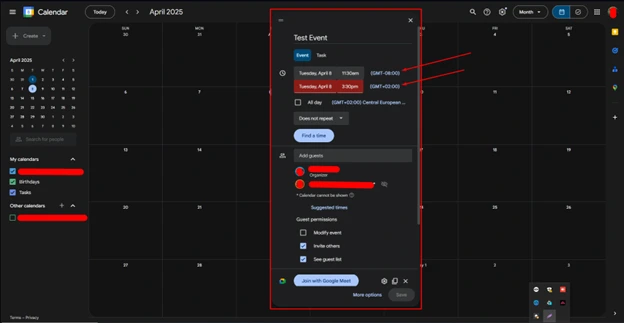
Practical Use Case Examples
Let’s say you’re in New York (EST) and scheduling a meeting with a client in London (GMT).
- Your meeting is at 10 AM EST.
- When you set the event with your time zone, the client sees it as 3 PM GMT on their calendar.
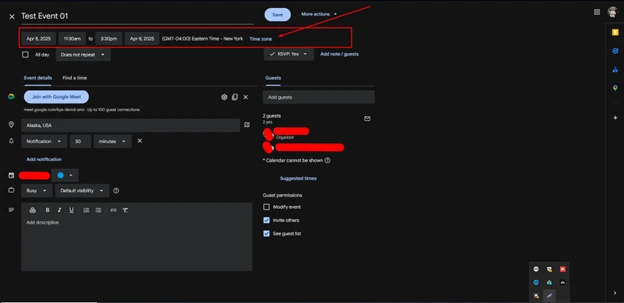
Setting up an event in New York time zone.
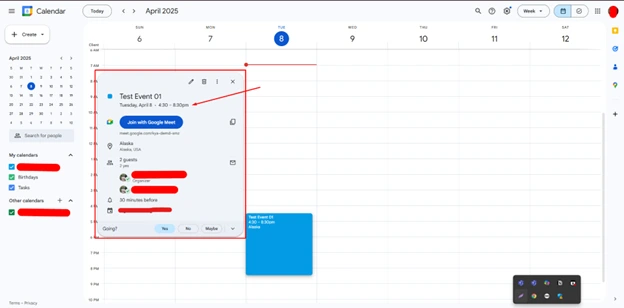
Client side timing in London Standard Time
This prevents confusion and keeps everyone aligned, no matter where they are.
Other everyday use cases include:
- Scheduling interviews across countries.
- Managing travel itineraries.
- Running webinars for global audiences.
- Planning product launches in regional time zones.
Customize Events for Better Time Zone Clarity
To make time-specific events easier to identify:
- Include the time zone in the event title.
Example: “Weekly Sync (PST)”
- Use color coding for different regions or teams.
- Mention both time zones in the description. For example, “8 AM PST / 11 AM EST—Zoom link below.”
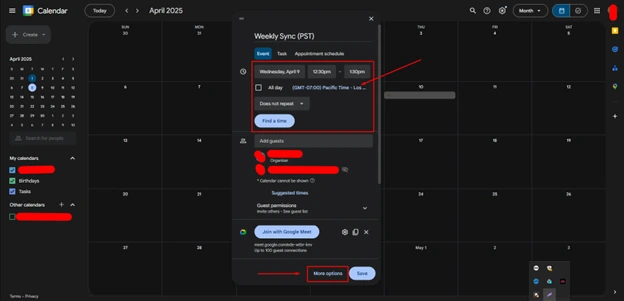
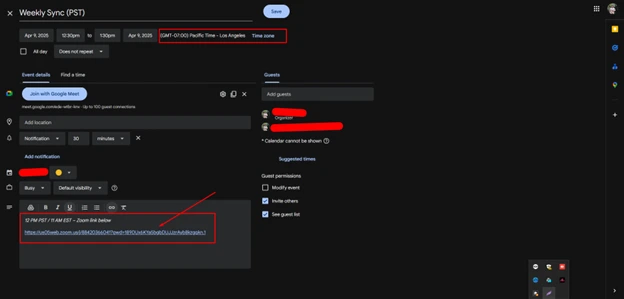
These small changes add clarity, especially when events are recurring or shared across large groups.
Quick Summary – Create Time Zone-Specific Events● Set time zone per event via the time picker. ● Google adjusts for all attendees automatically. ● Perfect for travel, client meetings, or global teams. ● Use labels, descriptions, and colors for clarity. |
Expert Tip: Use Recurring Events with Time ZonesWhen you schedule recurring events across time zones, always double-check the consistency of the time zone. For example: ● Set the initial event with a precise time zone. ● Choose the correct repeat pattern (weekly, monthly, etc.). ● If available, avoid daylight saving confusion by enabling the “This event follows time zone rules” toggle. |
It keeps long-term meetings synced, even when one region shifts due to daylight saving.
Use the World Clock for Better Visibility
The World Clock feature in Google Calendar allows you to view multiple time zones at a glance without opening an event. This is especially helpful when you’re coordinating with more than two regions.
This tool keeps your calendar clean and efficient by showing the current time across selected cities in the sidebar.
How to Enable the World Clock in Google Calendar
To activate the World Clock feature:
- Open Google Calendar in your browser.
- Click the gear icon and go to Settings.
- On the left menu, click “World Clock.”
- Check the box marked as “Show world clock.”
- Click “Add time zone” and choose the cities or zones you work with.
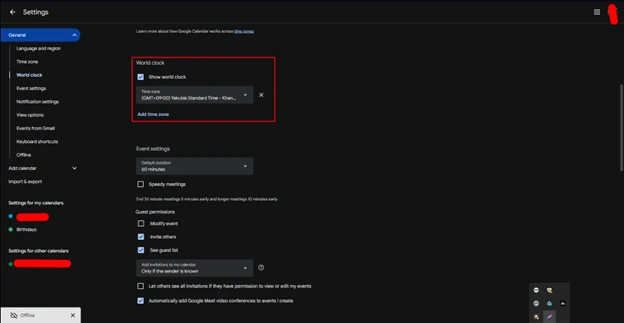
Your selected zones will appear on the left sidebar below your mini-monthly calendar.
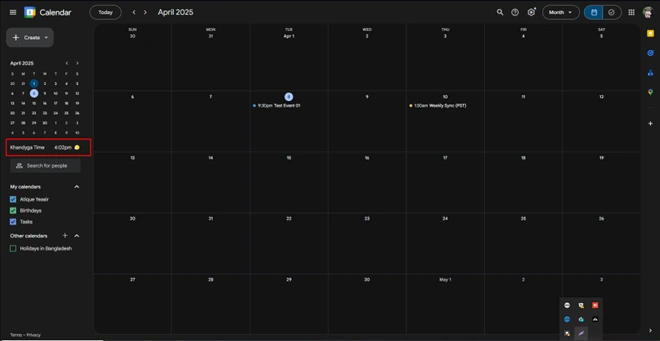
Best Ways to Use the World Clock
With the World Clock active, you can:
- Instantly compare time zones without opening events.
- See the current local time in other regions.
- Plan meetings faster by knowing the time overlap.
It is ideal when you’re:
- Working with 3+ time zones.
- Managing remote teams across continents.
- Booking interviews with global clients.
| Example: A content manager in Dehradun can monitor the London, Sydney, and New York Times to plan meetings and deadlines accordingly. |
Add and Organize Time Zones Strategically
To stay organized:
- Choose major cities where your contacts reside (e.g., Tokyo, Dubai, Toronto).
- Update the list when team members or clients change locations.
- Keep the most-used time zones at the top of the list.
You can reorder by deleting and re-adding zones in your preferred sequence.
Quick Summary – World Clock Tips● Enable via Settings > World Clock. ● Add multiple time zones as needed. ● View current times on the sidebar at all times. ● Great for scheduling across three or more locations. |
Expert Tip: Use Google Calendar with Google SearchPair the World Clock with Google Search for ultra-fast time conversion. Just search: “10 AM EST in IST” or “4 PM London time in Tokyo.” It gives instant results, helping you verify times before adding them to your calendar. |
This combo helps you stay precise and saves time, especially during last-minute scheduling.
Mobile Device Sync & Time Zone Behavior
Managing time zones from a mobile device is crucial for people on the go. Google Calendar’s mobile app handles most time zone adjustments automatically, but you should check a few key settings to ensure everything works smoothly.
This section explains how syncing works, what to expect while traveling, and how to avoid common mobile issues.
How to Enable “Use Device Time Zone”
Google Calendar can auto-adjust to your phone’s local time zone, but you need to enable this feature.
For Android:
- Open the Google Calendar app.
- Tap the menu icon and go to Settings.
- Select your Google account.
- Tap General > Use device time zone.
- Make sure it’s toggled ON.
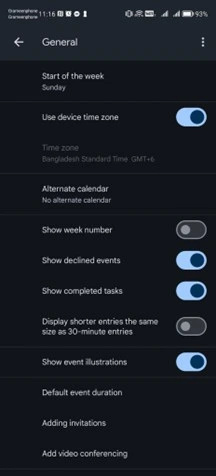
For iOS:
- Open the Settings app on your iPhone.
- Scroll to Calendar > Time Zone Override.
- Turn this OFF to let the calendar follow your current location.
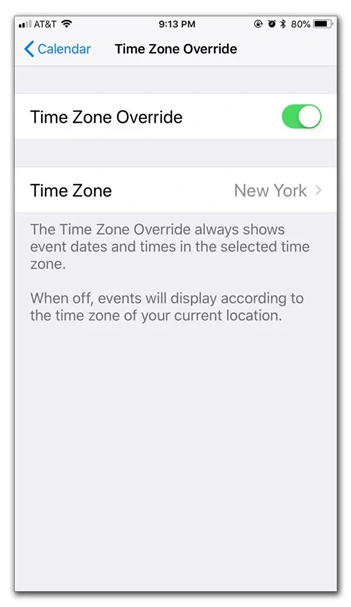
This ensures your events always display based on where you physically are.
What Happens When You Travel?
When you’re in a new time zone, your mobile device updates its clock using GPS or network data. Google Calendar syncs with this and:
- Automatically shifts event times to the new zone.
- Preserves meeting times accurately.
- Sends alerts according to your local time.
For example, if you created a 10 AM meeting in Delhi and traveled to Dubai, Google Calendar will show it as 8 AM (Dubai time).
Known Limitations and Potential Issues
Despite smart syncing, there are a few things to watch out for:
- Some phones may not update the time zone if the Location Services are off.
- Event times may shift incorrectly if the app is
- If you’ve manually set a time zone, it won’t auto-update while traveling.
To avoid conflicts:
- Keep your phone’s time set to
- Ensure Google Calendar has background sync permissions.
- Avoid editing event times during flights or in airplane mode.
Quick Summary – Time Zone Behavior on Mobile● Enable “Use device time zone” for auto-updates. ● Events adjust to new locations automatically. ● Manual overrides can cause mismatches. ● Keep Location and Sync enabled for real-time accuracy. |
Expert Tip: Manually Check Event Time Zones Before ConfirmingIf you’re creating or editing an event while abroad, tap the time field and verify the time zone shown underneath. This quick check avoids accidentally scheduling in the wrong time slot, which is especially useful when constantly switching time zones. |
Time Zone Tools Beyond Google Calendar
While Google Calendar is powerful, pairing it with additional tools can elevate your time zone management. These tools help when you’re juggling meetings, clients, or teams across four or more regions or dealing with complex scheduling.
Some top time zone tools complement Google Calendar and make planning even more seamless.
Top Tools for Time Zone Comparison
These apps and websites help you compare times across locations instantly:
World Time Buddy
- Side-by-side time zone comparison.
- Easy to drag and drop to find overlapping hours.
- Syncs with Google Calendar.
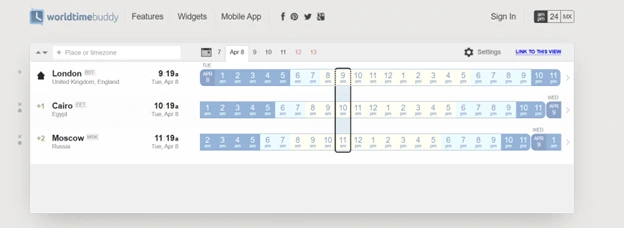
Time Zone Converter by TimeAndDate
- Precise city-to-city time conversion.
- Offers event planning with global invites.
- Great for one-off scheduling.
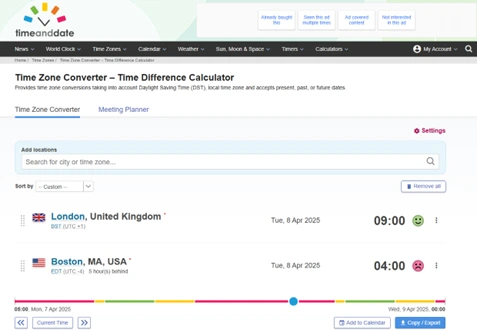
Calendly (with time zone detection)
- Automates appointment scheduling.
- Adjusts to each invitee’s time zone.
- Integrates directly with Google Calendar.
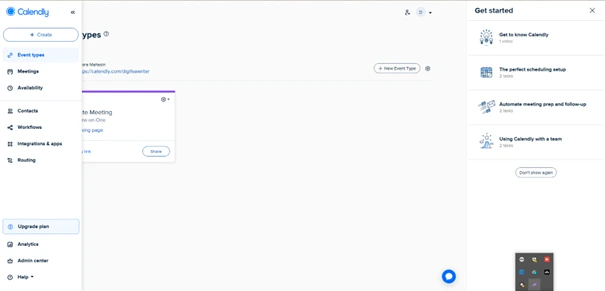
Chrome Extensions for Advanced Scheduling
If you use Google Calendar on desktop, try these Chrome extensions:
- FoxClocks – Displays multiple time zones in your browser footer.
- GcalTimeZone – Adds time zone indicators inside Google Calendar.
- Time Zone Converter – Quickly converts times while browsing.
These add-ons enhance visibility without disrupting your calendar workflow.
Why Combine Tools with Google Calendar
While Google Calendar handles basic scheduling and time zone syncing, these extra tools offer:
- More visual control.
- Real-time comparison for multiple cities.
- Better coordination for events with global audiences.
- Advanced scheduling automation with timezone logic.
Together, they help you save time, reduce errors, and look more professional to clients or colleagues.
Quick Summary – External Tools to Use● Use World Time Buddy or TimeAndDate for visual comparisons. ● Automate scheduling with Calendly. ● Add Chrome extensions like FoxClocks for browser-based time zone displays. ● Ideal for remote teams, freelancers, and consultants working worldwide. |
Expert Tip: Create a Time Zone Bookmark FolderCreate a browser folder with your most-used time zone tools (Google Calendar, World Time Buddy, TimeAndDate, Calendly). Name it something like “Time Tools.” That way, you can access everything with a single click, which is especially helpful when scheduling sprints or launching global campaigns. |
Common Mistakes to Avoid When Managing Time Zones
Managing multiple time zones can be tricky, and even a tiny oversight can cause scheduling issues. In this section, we’ll cover people’s most common mistakes and how to avoid them for flawless time zone management.
Not Updating Your Time Zone While Traveling
One of the most common mistakes is forgetting to update your time zone when traveling. If you don’t set your device to adjust automatically, Google Calendar will show events in the wrong time zone.
How to Fix It
- Always enable automatic time zone updates on your phone or laptop.
- Double-check your Google Calendar settings to ensure time zone adjustments are turned on.
Overlooking Daylight Savings Time (DST) Changes
Daylight Saving Time (DST) can be a real headache, especially when scheduling international events. Not all countries observe DST, and those that do may start or end on different dates.
How to Fix It
- Enable the “This event follows time zone rules” option when scheduling recurring events.
- Check your calendar for potential DST shifts and manually adjust event times.
Manually Changing Event Times Without Adjusting Time Zones
Sometimes, when manually setting event times, people forget to change the time zone. This results in meetings being scheduled at the wrong time for attendees.
How to Fix It
- Always set the correct time zone for each event, especially when working with multiple regions.
- Double-check that both the start and end times reflect the correct time zone.
When you schedule events with multiple participants, it’s easy to assume everyone is in the same local time. However, when others view the event, Google Calendar adjusts it based on their time zone, which is sometimes confusing.
How to Fix It
- Always include both time zones in the event description (e.g., “8 AM PST / 11 AM EST”).
- The invitation clarifies that the time zone is automatically adjusted to each attendee’s local time.
Creating Recurring Events Without Checking Time Zones
Recurring events often span across months or years. If the time zone isn’t set correctly, events may shift due to daylight saving changes or when traveling.
How to Fix It
- Ensure the time zone is set correctly at the beginning of the series.
- Use the time zone rules option to prevent recurring events from being impacted by DST.
Quick Summary – Common Time Zone Mistakes● Constantly update your time zone when traveling. ● Account for DST changes when creating events. ● Don’t forget to adjust the time zones for each event. ● Clarify time zones in shared events to avoid confusion. ● Check time zone settings when creating recurring events. |
Expert Tip: Test New Scheduling with a Dummy EventBefore sending invites for critical meetings or events, create a test event with a colleague or friend in another time zone. This ensures your settings and time zones are working correctly. Testing a new schedule helps confirm that everything appears correctly for all participants, preventing scheduling mistakes and improving professionalism. |
Final Tips for Managing Time Zones Like a Pro
Managing time zones doesn’t have to be a hassle. By following these expert tips and using the right tools, you can streamline your scheduling process and ensure that everyone stays on the same page, no matter where they are in the world.
Set Up Default Time Zones for Convenience
If you frequently work with specific regions, set up your Google Calendar with default time zones for each project or team. This will save you time and minimize the risk of making mistakes.
How to Set Default Time Zones
- In Google Calendar, go to Settings > Time Zone.
- Choose your default time zone for new events.
- For recurring events, you can set time zones manually as needed.
Use Time Zone Reminders for Critical Meetings
To avoid confusion, set up a Google reminder for essential meetings to alert attendees a few minutes before the event, especially if they’re in different time zones. This ensures no one misses out.
How to Set Time Zone Reminders
- Add a custom reminder in the event details
- Use the “Add notification” option to remind participants of the meeting in advance based on their time zone.
Schedule Flexibly Across Different Time Zones
For regular meetings or calls across multiple time zones, consider rotating meeting times to accommodate everyone. This can prevent certain team members from constantly having to join at inconvenient hours.
Tip for Rotating Times
- Rotate between different time slots: Morning in one time zone, afternoon in another.
- Use polling tools (e.g., Doodle, When2Meet) to help attendees select the best time for them.
Be Cautious with One-Time Events Across Time Zones
For single-use events or one-off meetings, always double-check the time zone setting. A small error could result in a missed opportunity or inconvenience for attendees.
How to Double-Check One-Time Events
- Confirm the time zone settings when scheduling the event.
- Use the World Clock tool to verify the corresponding time for other attendees.
Always Keep Time Zones in Mind During the Planning Stage
When planning global projects, presentations, or product launches, keep all participants’ time zones in mind from the start. Being proactive helps avoid conflicts later on.
How to Stay Proactive
- Share a calendar where all time zones are displayed.
- Add key time zone information to project timelines.
Quick Summary – Final Tips for Time Zone Mastery● Set default time zones for ease of scheduling. ● Add time zone reminders for important events. ● Rotate meeting times to accommodate different regions. ● Double-check time zones for one-time events. ● Stay proactive by considering time zones from the start. |
|
Create and share a time zone chart with your global team. Display key cities or time zones you work with so everyone can quickly convert meeting times without hassle. It acts as a reference guide to streamline communication and improve meeting planning. |
Conclusion
Managing multiple time zones on Google Calendar doesn’t have to be complex. By following the steps outlined in this guide, you can master your skills in setting time zones for events, using the World Clock, syncing your mobile device, and avoiding common mistakes.
Mastering time zone management will not only boost your productivity but also enhance your professionalism in global collaboration. If you are overwhelmed with your workload, you can hire expert VAs for calendar management from YesAssistant.
Implement the steps and share your feedback with us. Till then, keep up the good work!

